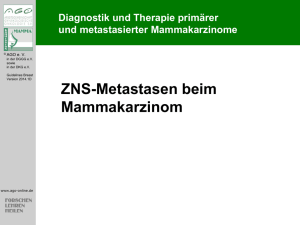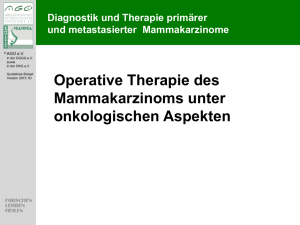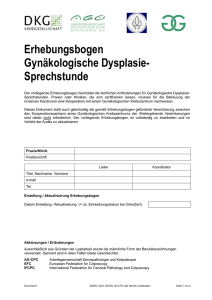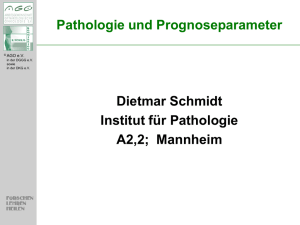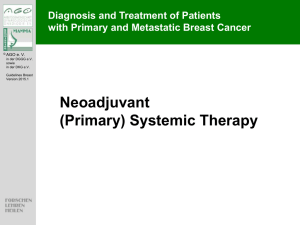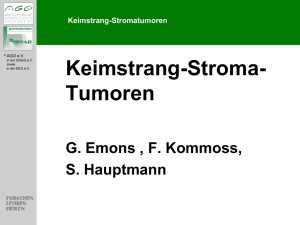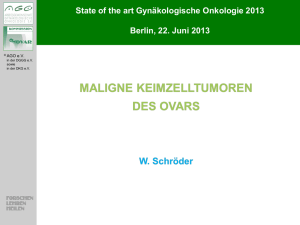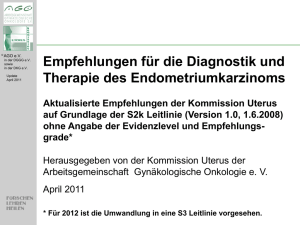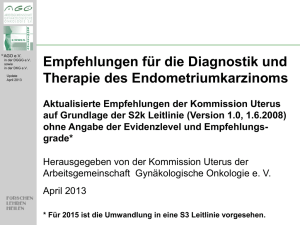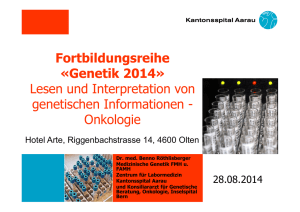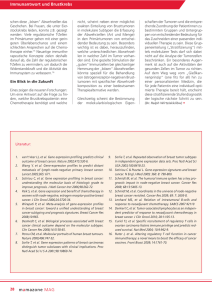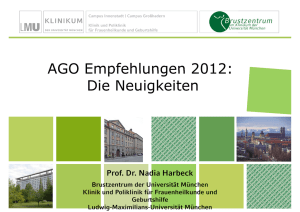Adjuvante Strahlentherapie – Konsensus zwischen DEGRO und AGO
Werbung
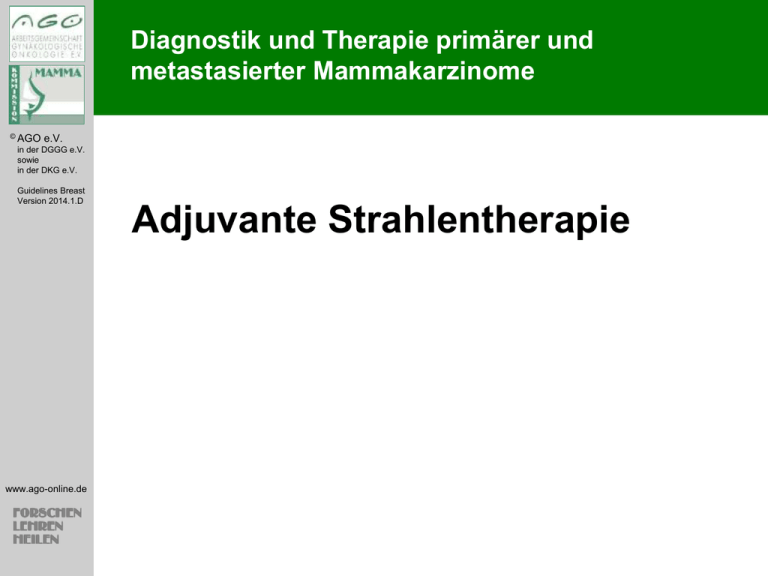
Diagnostik und Therapie primärer und metastasierter Mammakarzinome © AGO e.V. in der DGGG e.V. sowie in der DKG e.V. Guidelines Breast Version 2014.1.D www.ago-online.de Adjuvante Strahlentherapie Adjuvante Radiotherapie (RT) © AGO e.V. in der DGGG e.V. sowie in der DKG e.V. Guidelines Breast Version 2014.1D Versionen 2002 – 2013: Souchon / Blohmer / Friedrichs / Göhring / Janni / Möbus / Seegenschmiedt Version 2015: Thomssen / Kühn / Untch Budach / Wenz / Souchon www.ago-online.de Vorbemerkung © AGO e.V. in der DGGG e.V. sowie in der DKG e.V. Guidelines Breast Version 2014.1D www.ago-online.de Diese Empfehlungen zur adjuvanten Strahlentherapie bei Brustkrebs basieren auf einer Konsensusdiskussion zwischen Experten der Arbeitsgemeinschaft für Gynäkologische Onkologie (AGO) und Deutschen Gesellschaft für Radioonkologie (DEGRO) Für technische Details zur Durchführung der Strahlentherapie verweisen wir auf die entsprechenden aktualisierten Leitlinien der DEGRO 2014 Postmastektomie-Bestrahlung (PMRT)* der Thoraxwand © AGO Oxford / AGO LoE / GR e.V. in der DGGG e.V. sowie in der DKG e.V. Guidelines Breast Version 2014.1D www.ago-online.de >3 positive Lymphknoten 1-3 positive Lymphknoten (hohes Risiko) 1-3 positive Lymphknoten (niedriges Risiko*) T3 / T4 pT3 pN0 R0 (ohne zusätzliche Risikofaktoren) R0-Resektion nicht erreichbar (bei invasiven Tumoren) Bei jungen Patientinnen mit hohem Rückfallrisiko Nach primärer systemischer Therapie (NACT): RT basierend auf dem prätherapeutischen Stadium vor NACT: cN+, cT3/4a-d Verzicht auf RT bei ypT0 ypN0 nach PST (NACT)** Die Indikationen zur PMRT und regionalen RT sind unabhängig von der adjuvanten systemischen Therapie 1a 1a 5 1a 2b 1a 2b A A D A B A C ++ + +/++ +/++ ++ 2a 3b A C + +/- 1a A * Zur Definition „niedriges Risiko“ siehe FURTHER INFORMATION **Studienteilnahme empfohlen Möglich Definiton pN1a mit niedrigem Risiko © AGO e.V. in der DGGG e.V. sowie in der DKG e.V. Guidelines Breast Version 2014.1D www.ago-online.de Kyndi et al. Radiother Oncol 2009: Risk for lokoregional recurrence <10%, If at least 3 out of 4 favourable criteria are present: • Hormone receptor status positive • Grad I • Her2 negative • tumor <2 cm Truong et al. IJROBP 2005: Risk for lokoregional recurrence <10%, if all or of the following 3 criteria are present: • age >45 years • <25% of resected LN involved • Hormone receptor status positive Adjuvant radiotherapy after mastectomy – EBCTCG update 2014 Only patients with adequate axllary disection included © AGO e.V. in der DGGG e.V. sowie in der DKG e.V. Guidelines Breast Version 2014.1D www.ago-online.de Early Breast Cancer Trialists’ Collaborative Group, Lancet 2014 Adjuvant radiotherapy after mastectomy – EBCTCG update 2014 Adjuvant RT also in case of 1 positive nodes also beneficial Early Breast Cancer Trialists’ Collaborative Group, Lancet 2014 Radiotherapie (RT) nach brusterhaltenden Operationen (BEO; invasive Karzinome): - Bestrahlung der Brust © AGO LoE 1b B e.V. in der DGGG e.V. sowie in der DKG e.V. Guidelines Breast Version 2014.1D www.ago-online.de AGO ++ < 40 Jahre Konventionelle RT (25-28 Fraktionen) mit integriertem oder sequentiellem Boost 40 – 65 J. Konv. RT mit integriertem oder sequentiellem Boost, oder hypofraktionierte RT mit sequentiellem Boost > 65 Jahre Niedriges Risiko: hypofraktionierte RT ohne Boost erwägen (15 -16 Fraktionen) Hohes Risiko: RT wie für 40-65 Jahre Ältere Pat. Individuelle Beratung einschließlich Verzicht auf RT je nach individuellem Risiko und geriatr. Einschätzung Jedes Alter Bei zusätzlicher Bestrahlung der Lymphabflußwege konventionell fraktionierte RT (25-28 Fraktionen) (Lymphabflusswege) Studienteilnahme empfohlen Which hypofrationation schedule is optimal? The START B 5x 2.66 Gy/we. to 40 Gy Teilbrustbestrahlung nach BEO beim invasiven Karzinom © AGO e.V. in der DGGG e.V. sowie in der DKG e.V. Guidelines Breast Version 2014.1D www.ago-online.de Oxford / AGO LoE / GR Boost-RT des Tumorbettes (verbesserte lokale Kontrolle, kein Überlebensbenefit) 1b B < 40 Jahre 1b B 40 - 60 Jahre 1b B > 60 Jahre, G3 oder >pT1 2b B Intraoperative Radiotherapie (IORT/IOERT) Als Boost-Bestrahlung vor Ganzbrust-RT 2a B Als alleinige Radiotherapie-Massnahme (pT1pN0R0G1-2, non-lob., >50 J., kein extensives DCIS, HR+) IORT während Erst-Op. 50 kV 1b B IOERT während Erst-Op. 1b B Postoperative Teilbrustbestrahlung als alleinige Radiotherapie-Massnahme (bei selektionierten Pat. , ASTRO Konsens) Interstitielle Brachytherapie 1b B Intrakavitäre Ballontechnik 1b B APBI (IMRT) 1a B + ++ ++ +/- + +/-* +/-* +/-* -* -* *Studienteilnahme empfohlen Boost vs no Boost: EORTC 22881-10882 Trial © AGO e.V. in der DGGG e.V. sowie in der DKG e.V. Guidelines Breast Version 2014.1D @20 yrs (95% C.I.) Overall Survival (=-1.4%) Boost (n=2.661) No boost (n=2.657) Hazard Ratio (95% C.I.) 59.7% (56.3–63.0) 61.1% (57.6–64.3) HR 1.05 (0.92–1.19) n.s. Cumulative Risk of Ipsilateral Breast Tumour Recurrence www.ago-online.de All patients 12.0% (9.8–14.4) 16.4% (14.1–18.8) HR=0.65 (0.52–0.81); p<0.0001 ≤40 years (=11.6%) 24.4% (14.9–33.8) 36.0% (25.8–46.2) HR=0.56 (0.34–0.92); p=0.003 41–50 years (=5.9%) 13.5% (9.5–17.5) 19.4% (14.7–24.1%) HR=0.66 (0.45–0.98); p=0.007 51–60 years (=2.96%) 10.3% (6.3–14.3) 13.2% (9.8–16.7) HR=0.69 (0.46–1.04); p=0.020 >60 years (=3.0%) 9.7% (5.0–14.4) 12.7% (7.4–18.0) HR=0.66 (0.42–1.04); p=0.019 (Median F/U 17.2 y) nach: Bartelink et al. Lancet Oncol 2015; 16: 47–56 Partial breast irradiation (IORT) vs. whole breast radiotherapy: TARGIT randomized trial all patients subgroups subgroups Vaidya et al. Lancet 2013 Partial breast irradiation (IOERT 21 Gy) vs. whole breast radiotherapy (WBI 50 Gy / 2 Gy) ELIOT randomized trial (n=1305) In breast recurrence Overall survival Multivariate: Risk for IBTR (suggesting WBI) Factor >2 cm tumor > 3 positive LN G3 triple-negative HR 2.24 2.61 2.18 2.40 95% CL 1.03 - 4.87 0.91 - 7.50 1.00 - 4.79 0.94 – 6.10 Veronesi et al. Lancet Oncol 2013 Radiotherapie der Axilla © AGO Oxford / AGO LoE / GR e.V. in der DGGG e.V. sowie in der DKG e.V. Guidelines Breast Version 2014.1D Tumorresiduen nach axillärer Dissektion 5 D ++ Sentinel-Lymphknoten negativ 1 B -- Axilladissektion nicht indiziert (z.B. cN0 mit pos. SLN; s. operat. Therapie) 2a B -- Extrakapsulärer Tumorwachstum (ECS) 2b B -- 1b B -- Axilläre Mikrometastasen oder isolierte Tumorzellen in regionalen Lymphknoten www.ago-online.de Axillary Dissektion oder Radiotherapie (RT) der Axilla 1-2 pos SLN: © AGO e.V. in der DGGG e.V. sowie in der DKG e.V. Guidelines Breast Version 2014.1D Oxford / AGO LoE / GR BET: keine weitere Behandlung der Axilla (Kriterien gemäß ACOSOG Z011) 1b B +/-* BET: Axilläre Dissektion 1b B +/-* BET: Radiotherapie der Axilla 1b B +/-* 1b B + D +/- 5 D ++ Axilläre Dissektion 1b B ++ Radiotherapie der Axilla 1b B + Mastektomie: Wenn eine RT der Thoraxwand indiziert ist, Axilläre Dissektion oder RT der Axilla Kein Behandlung der Axilla (ACOSOG Z011-Krit.) 5 Wenn eine RT der Thoraxwand nicht geplant ist Axilläre Dissektion oder RT der Axilla >=3 positive SLN www.ago-online.de *Studienteilnahme empfohlen 1-2 positive sentinal nodes Axillary dissection vs. axillary RT © AGO Axillary dissection vs. no (all tangential breast RT e.V. in der DGGG e.V. sowie in der DKG e.V. Guidelines Breast Version 2014.1D www.ago-online.de Donker et al. Lancet Oncol 2004 Giuliano et al. JAMA 2011 Radiotherapie (RT) der übrigen lokoregionalen Lymphabflussregionen © AGO e.V. in der DGGG e.V. sowie in der DKG e.V. Guidelines Breast Version 2014.1D RT der supra-/infraklavikulären Lymphregion: Oxford / AGO LoE / GR ≥ pN2a 1b A ++ Level III befallen 1b A ++ pN1a high risk 2b B + pN1a low risk* 2b B +/- pN0 high risk, wenn eine RT der A. mammaria interna-Lnn. Indiziert ist (s. unten) 2a B +/- After NACT/NAT bei cN+(Indikationen wie für PMRT) 2b B + 1ba B + pN0 high risk mit zentral/medial gelegenen Tumoren und HR-positiv, wenn eine adjuvante systemische Chemotherapie erfolgt ist 1ba B +/- IMC-RT, wenn kardiale Risikofaktoren vorliegen oder wenn Trastuzumab gegeben wird 2b A -- RT der A. Mammaria-interna-Lymphabflussregion (IMC) pN1-pN2 und HR-positiv, wenn eine adjuvante systemische Chemotherapie erfolgt ist www.ago-online.de * Zur Definition „niedriges Risiko“ siehe FURTHER INFORMATION Meta-analysis: whole breast (WBI)/chest wall (CW) RT vs. WBI/CWI + regional lymph nodes N+ or medial/central tumor location Overall Survival Comparison I: (MS+IM)+(WBI/CWI) vs. (WBI/CWI) MA.20 [16]: n=1832; HR 0.76 (95% CL 0.56 - 1.03) EORTC [17]: n=4004; HR 0.87 (95% CL 0.76 - 1.00) Subtotal*: n=5836; HR 0.85 (95% CL 0.75 - 0.96) p=0.011 Comparison II: IM+(WBI/CWI+MS) vs. (WBI/CWI+MS) French [15]: n=1334; HR 0.94 (95% CL 0.79 - 1.11) Subtotal: n=1334; HR 0.94 (95% CL 0.79 - 1.11) p=0.80 Comparison I+II Total**: n=7170; HR 0.88 (95% CL 0.80 - 0.97) 0.3 *= fixed effect model ** = random effect model MS = medial supraclavicular LN IM = internal mammary LN 0.4 p=0.012 0.5 0.6 LN RT better 0.8 1.0 Hazard Ratio 2.0 no LN RT better W. Budach et al. Radiat Oncol 2013 ECCO Amsterdam 2013 Multivariate Analysis of Overall Survival: Effect of Radiotherapy of the Internal Mammaria Lymph Nodes © AGO (median follow-up 10.9 yrs) e.V. in der DGGG e.V. sowie in der DKG e.V. Guidelines Breast Version 2014.1D www.ago-online.de n* Hazard ratio (95%CI) No adjuvant reported 625 0.91 (0.59 - 1.39) Chemotherapy 954 1.05 (0.84 - 1.32) Endocrine therapy 1185 0.82 (0.63 - 1.06) Both (endocrine th. and chemotherapy) 1200 0.72 (0.55 – 0.94) Total 4004 0.88 (0.76 – 1.01) Adjuvant treatment * missing data on 40 patients Poortmans et al. ECCO Amsterdam 2013 Kombination systemischer Therapien mit simultaner Radiotherapie © AGO e.V. Oxford / AGO LoE / GR in der DGGG e.V. sowie in der DKG e.V. Guidelines Breast Version 2014.1D Trastuzumab simultan zur Radiotherapie Tamoxifen simultan zur Radiotherapie AI (Letrozol) simultan zur Radiotherapie 2b B + 2b C + 2a B + www.ago-online.de *Bei HER2-positiven Tumoren sollte eine parasternale RT generell vermieden werden; keine simultane Trastuzumabtherapie bei parasternaler RT. Radiatio im Alter nach brusterhaltender Operation © AGO e.V. in der DGGG e.V. sowie in der DKG e.V. Oxford / AGO LoE / GR Guidelines Breast Version 2014.1D Verzicht auf Radiotherapie der Brust bei Pat. mit niedrigem Rezidivrisiko, wenn eine adjuvante endokrine Therapie (z.B. 5 J. Tamoxifen) konsequent durchgeführt wird* 1b B Lokalrezidiv erhöht, aber kein Einfluss auf Gesamtüberleben, Verminderung der Toxizität www.ago-online.de * Alter ≥ 70 J., pT1, pN0, HR-pos., G1-2, HER2-negativ, Resektionsrand >1 mm + Summary of results: No RT vs. RT in low risk patients (T1N0, ER+) Reference n local recurrence Tam HR p OS Tam+RT eldery Fyles et al. NEJM 2004 611 12.2% @8y. 3.6% @8y 0.20 Hughes et al. JCO 2013 636 17.0% @10y. 7.0% @10y. 0.18 <0.001 n.s 4.1% @5y. 1.3% @5y. 0.19 0.0002 n.s 9.5% @6y. 0.5% @6y. 0.10 <0.001 n.s Kunkler et al. Lancet Oncol 2015* 1326 <0.001 n.s postmenopausal Pötter et al. IJROBP 2007 *=T2 <3cm included 831 No RT vs. RT in low risk patients (T1-T2<3cm,N0, ER+) Locale recurrence Fyles NEJM 2004 Hughes JCO 2013 Pötter IJROBP 2007 Kunkler Lancet Oncol 2015 Years Summary of results: No RT vs. RT in low risk patients (T1N0, ER+) Reference n Mastectomy Tam HR p Tam+RT eldery Fyles et al. NEJM 2004 611 no data. no data Hughes et al. JCO 2013 636 4% @10y. 2% @10y. Kunkler et al. Lancet Oncol 2015* 1326 12 @5y. 2 @5y. no data - 0.5 n.s. 0.18 n.s. postmenopausal Pötter et al. IJROBP 2007 *=T2 <3cm included 831 no data. no data no data - A randomised controlled trial of post-operative radiotherapy following breast-conserving surgery in a minimum-risk population. Quality of life at 5 years in the PRIME trial Functionality Symptoms Quality of life Fatique Insomia Breast symptoms Williams et al. Health Technology Assessment 2011
